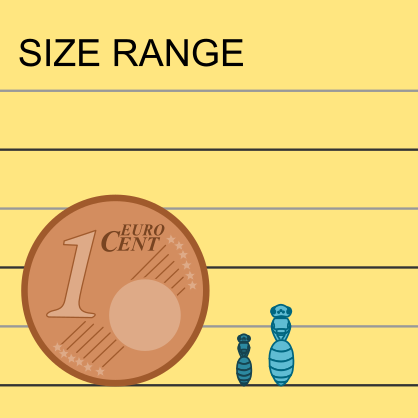Author: Popov, 1952
|
Type species: Osmia latipes Morawitz, 1875 = Osmia brachyura Morawitz, 1875, monobasic
|
Clade: Anthophila
Family: Megachilidae SubF: Megachilinae Tribe: Osmiini |
|
Distinctive traits
|
Pictures of distinctive traits.
|
Morphologically close genera and how to distinguish them
Osmia species have very short parapsidal lines and no elargement of the basitarsus of the anterior legs.
Hoplitis species tend to be larger, they have no elargement of the basitarsus of the anterior legs.
Chelostoma & Hofferia species have no long hairs at the apex of the labrum. Scutellum as long or longer than the ITD.
Heriades & Stenoheriades species do have a transverse carina on the T1.
Protosmia species have a marked propodeal triangle and a slender body-shape.
- Haetosmia - Osmia
Osmia species have very short parapsidal lines and no elargement of the basitarsus of the anterior legs.
- Haetosmia - Hoplitis
Hoplitis species tend to be larger, they have no elargement of the basitarsus of the anterior legs.
- Haetosmia - Chelostoma & Hofferia
Chelostoma & Hofferia species have no long hairs at the apex of the labrum. Scutellum as long or longer than the ITD.
- Haetosmia - Heriades & Stenoheriades
Heriades & Stenoheriades species do have a transverse carina on the T1.
- Haetosmia - Protosmia
Protosmia species have a marked propodeal triangle and a slender body-shape.
General comments on Haetosmia species identification
Females can be diagnosed by the probasitarsus. Males require genitalia and sternites evaluation.
Females can be diagnosed by the probasitarsus. Males require genitalia and sternites evaluation.
Sorry, but the species identification tool is not yet available for Haetosmia.
Please check the reference(s) below for traditional keys.
Please check the reference(s) below for traditional keys.
List of the Haetosmia species found in Europe (Ghisbain et al. 2023):
Haetosmia circumventa (Peters, 1974)
Haetosmia circumventa (Peters, 1974)
References with identification keys for some of the species:
- Müller A., Griswold T. 2017. Osmiine bees of the Genus Haetosmia (Megachilidae, Osmiini): biology, taxonomy and key to species. Zootaxa, 4358(2) : 351-364.
Online resources:
Palearctic Osmiine Bees (Palearctic)
Exotic Bee ID (World)
Discover Life (World)
WestPalBees (West Palearctic)
Palearctic Osmiine Bees (Palearctic)
Exotic Bee ID (World)
Discover Life (World)
WestPalBees (West Palearctic)
Page contributors:
You noticed a mistake? You have a suggestion to improve this page?
Don't keep it to yourself, please contact us and become a contributor to IDmyBee!
- Adrien Perrard (Dec. 2023)
- Adrien Perrard (Dec. 2019)
You noticed a mistake? You have a suggestion to improve this page?
Don't keep it to yourself, please contact us and become a contributor to IDmyBee!
References used to write this page:
- Ghisbain, G., Rosa, P., Bogusch, P., Flaminio, S., Le Divelec, R., Dorchin, A., Kasparek, M., Kuhlmann, M., Litman, J., Mignot, M., Müller, A., Praz, C., Radchenko, V.G., Rasmont, P., Risch, S., Roberts, S.P.M., Smit, J., Wood, T.J., Michez, D. & Reverte, S. (2023). The new annotated checklist of the wild bees of Europe (Hymenoptera: Anthophila). Zootaxa, 5327(1), 1-147.
- Michener, C.D. 2007. The Bees of the World, 2nd Edition. The John Hopkins University Press, Baltimore.
- Michez D., Rasmont P., Terzo, M., Vereecken, N. 2019. Abeilles d'Europes. Hymenoptères d'Europes, Volume 1. N.A.P. Editions.
- Nieto, A., Roberts, S. P., Kemp, J., Rasmont, P., Kuhlmann, M., García Criado, M., ... & Michez, D. 2014. European red list of bees. Luxembourg: Publication Office of the European Union, 98.
- Rasmont, P., Devalez, Jelle, Pauly, A., Michez, D. & Radchenko, V.G. 2017. Addition to the checklist of IUCN European wild bees (Hymenoptera: Apoidea). Annales de la Société entomologique de France 53: 17-32.



